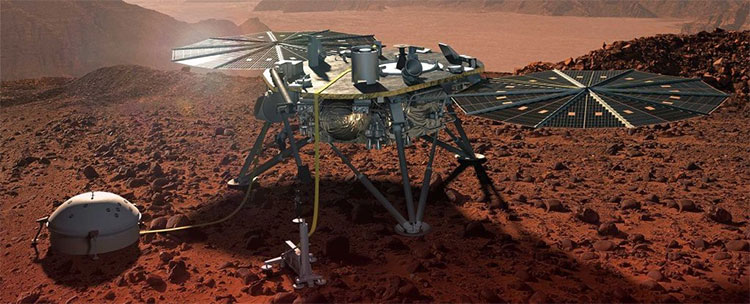NASA announced the first recording of the earthquake on Mars
Do you remember NASA's InSight ship? It is the exploration ship that landed on the surface of Mars on November 26, 2018, carrying with it the task of collecting geological data of the Red Planet.
Since that time, InSight has provided us with many valuable Martian materials, from surface scans, and also the sound of the wind being recorded, helping us hear the first sound in history. Discover this planet.

Spacecraft Insight.
And recently, InSight went on to create another victory, and this time it was an earthquake sound recording. The small, faint, unmistakable but unmistakable earthquakes are taking place deep underground.
The initial analysis confirmed that these seizures actually originated in the planet's core . And now, they are actively working to determine exactly what is the cause of this earthquake.
It is known that Mars earthquakes are like Earth, which can reveal facts inside the planet core. InSight ships are equipped with the latest tools to collect data about them - including temperature, direction of rotation and geological activity.
Most of the data collected is mostly sound around the ship. However, on April 6, InSight finally brought what they were expecting, with a signal named Sol 128 .
And indeed, it is the sounds that are very . haunting, according to the astronomical astronomical community.
Earthquake sound on Mars.
"We have been waiting for months to see this signal," - Philippe Lognonné from Paris Global Physics Institute (IPGP) said.
"It is really exciting to be able to prove that Mars has a strong geological activity. We will share the results in detail after completing the analysis."
A geological wave in the planet's core can operate instead of radar waves. While crossing the ground, they can slow down before a few materials, or reflect, change direction . All are data to analyze the planet's core components.
However, unfortunately, Sol 128 is too weak for scientists to erect the inner structure of the planet. If this signal occurs on Earth, it will certainly disappear before our numerous geological vibrations are available.
However, it also opens up the hope that there will be a larger earthquake that will appear in the future, especially the recently discovered Sol 105, 132, 133 signals.
In the detected signals, Sol 128 is the strongest and also the most interesting signal, because it is almost identical to the seismic that was measured at the surface of the Moon during 1969 - 1977, by the ship. Apollo provides.

Most of the data collected is mostly sound around the ship.
Like Mars, our Moon does not have a lot of internal geological activity, and activity levels are getting smaller, just the remainder after being formed 4.5 billion years ago. When the Moon core shrinks, it creates pressure on the outer shell, which gradually cracks and creates seismic activity.
Based on what happens to the Moon, scientists believe that the geological activity on Mars is almost the same. However, future studies still need to continue to confirm this conclusion.
"The first InSight data is like a continuation of what Apollo has done, " - quoted Bruce Banerdt, NASA's InSight director of investigation.
"This is the first time we have officially entered a new field: geological activity on Mars."
- NASA spacecraft recorded for the first time the Martian wind
- NASA plans to 'eavesdrop' on Mars
- NASA first detected the
- NASA equipped lasers for Mars to explore Mars
- NASA announced a model for astronauts on Mars
- NASA announced an unexpected image of the
- NASA launches a research probe into the earthquake on Mars
- NASA suddenly announced shock about life on Mars
- NASA explains the human skeleton image on Mars
- Announced 3 houses on the Moon and Mars
- NASA has just taken a monstrous photo that looks like a fake about Mars
- NASA announced plans to send people to Mars
- NASA discovered giant ice on Mars
 Announced 3 houses on the Moon and Mars
Announced 3 houses on the Moon and Mars Science proves: Mars also knows 'deflated'
Science proves: Mars also knows 'deflated' Elon Musk announced the price for a Mars trip was 11.6 billion VND, free of charge
Elon Musk announced the price for a Mars trip was 11.6 billion VND, free of charge NASA discovered strange 'gate' on Mars, is the hiding place found?
NASA discovered strange 'gate' on Mars, is the hiding place found?